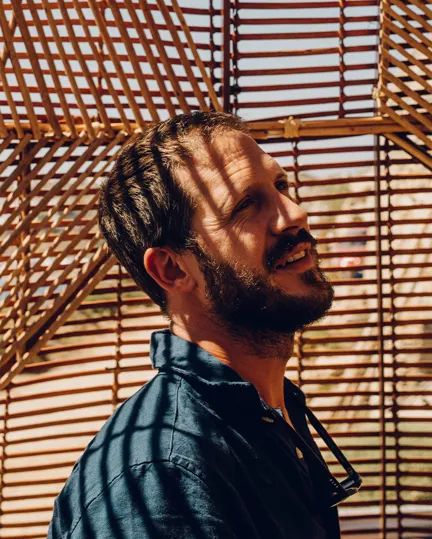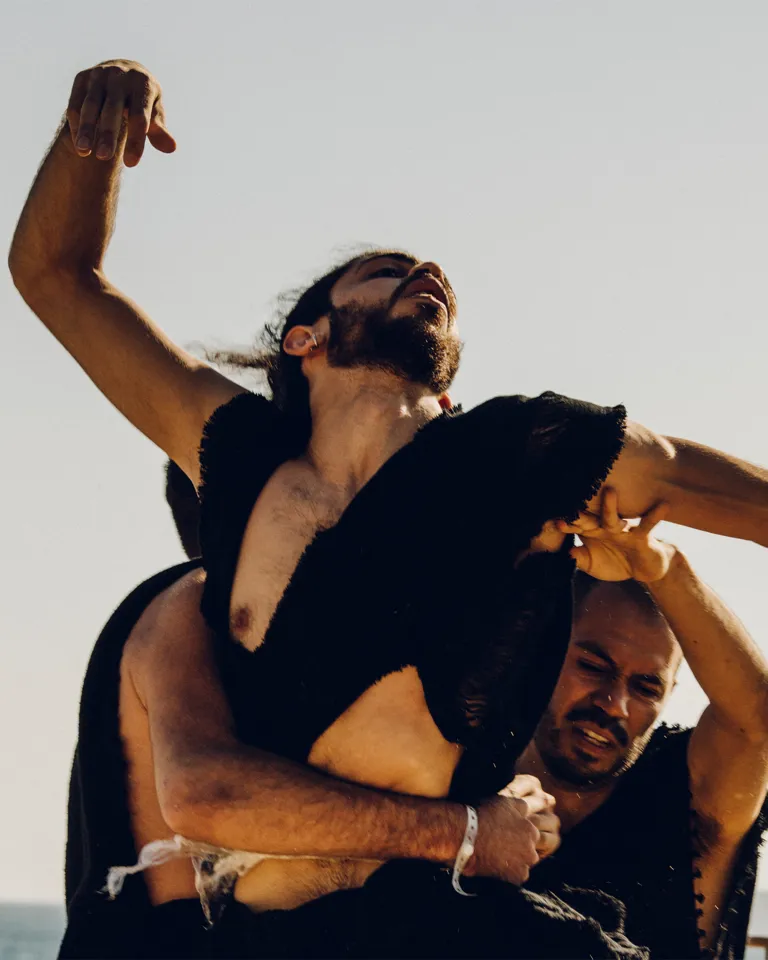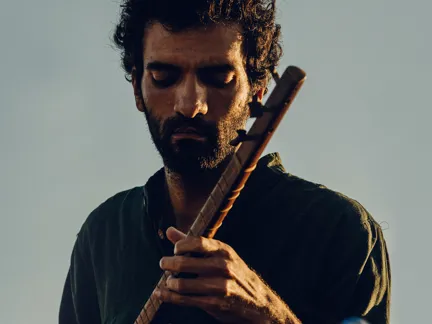Incubating future movements in travel and culture
Words Frankie WechslerFilm Eldon van Aswegen
Today, the Greek island of Mykonos is one of Europe’s top beach destinations, while Delos, its tiny neighbor to the southwest, is an island of ruins. But long before Mykonos—or Europe for that matter—even existed, Delos held a magical, mythical, world-changing significance across the ancient world.
The mythological birthplace of the sun god Apollo, the island of Delos was the site of what might have been the first cross-cultural festival in human history—the Delia—a quadrennial celebration that drew diverse travelers from across the ancient world for singing, dancing, feasting, and every form of physical enjoyment the mind can conjure. It was this history that served as the jumping-off point for Further Mykonos: The Eternal Festival, which as the above film elucidates, brought the South African festival artist Daniel Popper to Mykonos to construct a large-scale figurative sculptural installation that reinterprets the story of Apollo’s birth, building a metaphorical bridge between the Scorpios peninsula and ancient Delos. To mark the sculpture’s unveiling, a three-day music and arts gathering celebrated the legacy of the Delia at a time when festival culture is once again ascendant, from contemporary gatherings like Burning Man and Primavera Sound, to the resurgence of more traditional festivals, like the world sacred music gatherings in Fez and Rajasthan.
“For me, it's the future,” said the French-Iranian opera singer and Further resident Ariana Vafadari, who sets Zoroastrian mantras called Gathas, sung in the old Persian language, to new music of her own composition that she plays at festivals around the world. “What you guys are doing here—it’s really where we all are going,” said Vafadari. “I'm a mixture of cultures. I love electronic music. I love dancing. I love opera. I love going to a city hall with very classical music, but in September I was singing at Burning Man.”
With the island of Delos behind her across the sea and Popper’s sculpture four-meter rattan-and-wicker sculpture, “Leto,” hovering beside her, Vafadari performed a set of Gathas at Scorpios, following an original dance piece by the Berlin-based Syrian dance collective Dabkesim and a performance by Quieter Than Silence, a musical project by the Vienna-based Iranian musician and researcher Mehdi Aminian and Syrian oud player Mohamad Zatari. All of these artists are thriving and evolving within the new festival landscape, breathing new life into traditional art forms and bridging east and west, the past and the present, the sacred and the secular.


“I build on top of what's in the past,” said Aminian, who in 2013 founded Roots Revival, an organization that brings together musicians across different cultures to find commonalities between musical styles, traditions, and instruments. “I think that's a healthy way of looking at traditional music,” he added. “You should make it evolve. Traditional music is not a static thing.”
The idea of festivals as sites for unexpected synthesis and laboratories for new ideas propelled a far-reaching conversation between Daniel Popper, Marcus Fairs, the founder of the influential design and architecture magazine Dezeen, and the French architect Arthur Mamou-Mani. Festivals, said Mamou-Mani, have become “an architectural playground of experimentation." A trailblazer of a new breed of pop-up, digital-fabrication-led architecture, he is probably best known for creating an immense, spiraling 3D-printed wooden temple at Burning Man. “[It’s] a place where we as architects can free ourselves from normal conditions,” added the architect and professor, who has been bringing his architecture students from the University of Westminster to Burning Man for years. In that sense, it’s not just a laboratory but a classroom, as well.

For Popper, who began his career creating large-scale immersive installations for festivals like AfrikaBurn, festivals are an ideal venue for people to experience his art. “They're in an environment where they're very open,” he said. “There's music. There's dancing, and there's a sense of accessibility and freedom. It’s totally different to the white walls of a gallery,” he added. “It’s a whole new way of experiencing and accessing artwork.”
In creating the installation for Further Mykonos, Popper looked to the mythological story of Leto the Titaness, the mother of Apollo and his twin sister Artemis, who according to myth, had to flee the mainland after she was impregnated by Zeus to escape his jealous wife Hera. No island would take her in until she eventually found a free-floating rock that accepted her. Once Apollo was born, he filled the sky with sunlight and anchored the rock—Delos—to the sea.


“It’s a really beautiful story,” said Stelios Brigos, the vice governor and head of culture for the South Aegean who came to attend Further Mykonos. “The name of Delos in Greek means the place that’s declared,” he added. “It‘s like a declaration of existence, the declaration of life that was born there.” In fact, the entire island chain of the Cyclades, said Brigos, was conceptualized around Delos. “Cyclades in Greek means a small circle… Delos is exactly in the center of this island complex. It’s a circle around Delos.”
Yet the great importance of Delos had largely been forgotten, said Brigos. “Mykonos is one of the most important touristic places in the world,” but many people—even locals—don’t know how it first became known. “Delos was the reason,” said Brigos, “because these people, the first tourists, came in the decades of the 1920s and 1930s, just to know Delos, just to see with their eyes the beautiful monuments.”


But recently, a new generation is rediscovering the tiny ancient island, though projects like Further Mykonos and “Sight,” a site-specific exhibition by the British artist Antony Gormley in collaboration with Greece’s pre-eminent contemporary arts organization, Neon, and the Ephorate of Antiquities of Cyclades running until October on the archaeological site and the Museum of Delos Island. The British sculptor has created 29 iron “body forms”, several cast from his own body, that are the first artworks to be installed on Delos since it was inhabited more than 5,000 years ago.
When you walk through the ruins of Delos today, you see not only classical ancient Greek architecture but depictions of Syrian deities, a temple to the Egyptian goddess Isis, the ruins of a synagogue, Phoenician, Italian, and Palestinian artifacts—indicative of Delos’ time as a cultural melting pot. So it was important that The Eternal Festival bring together artists from across the world—like the celebrated Turkish DJ, musician, and composer, Mercan Dede, whose music blends elements of Sufi music and dance with electronic music to create an utterly contemporary, unique musical style that has been embraced across the global festival circuit. He closed The Eternal Festival with a stunning sunset performance accompanied by a whirling dervish dancer.
“We have so many people on this island, and we have to provoke them to go to Delos,” said Brigos. With Further Mykonos, he continued, “people will come. They will hear this story. We will have artists from around the world. This is magnificent. Because one beautiful festival gives us the opportunity to think about where everything started.” He added: “Without our past, we cannot construct our future.”
The Eternal Festival

French architect Arthur Mamou-Mani is pioneering a new direction in temporary architecture, employing cutting-edge digital technology and radical new perspectives on shared space.
The Eternal Festival

Further speaks to the spikey-haired Turkish luminary, whose singular sonic output melds ancient mysticism and musical traditions with contemporary electronic sounds.
The Eternal Festival

Further meets Persian-French opera singer Ariana Vafadari, who takes enigmatic Zoroastrian prayers from 3700 BC and transforms them into haunting operatic pieces that speak to 21st-century festival goers.